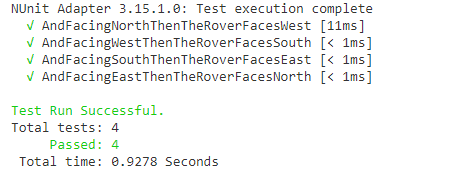Mars Rover – Implementing Rover : Turning Left
Welcome to the seventh installment of Learning Through Example – Mars Rover! In this post, we’re going to start driving out the functionality for the Rover and the business rules for turning left! First, we’ll take a look at the requirements to make sure we have an idea of what’s needed. From there, we’ll start implementing the requirements. By the end of this post, we’ll have a Rover that can do 3/4 of the possible commands!
Turning in Place By Turning Left
If we look back at the original requirements for turning left, we find this single line as the requirement
When the rover is told to turn left, it will rotate 90 degrees to the left, but not change its location
Given this requirement, we’re able to double check with our Subject Matter Expert that the Rover is essentially rotating in place which yields the following requirements.
- Given the
Roveris facingNorth, when it turns left, then theRovershould be facingWestat the same Coordinate - Given the
Roveris facingWest, when it turns left, then theRovershould be facingSouthat the same Coordinate - Given the
Roveris facingSouth, when it turns left, then theRovershould be facingEastat the same Coordinate - Given the
Roveris facingEast, when it turns left, then theRovershould be facingNorthat the same Coordinate
Even though we’ve not written tests that have this exact setup, it looks like we should be able to use that as a start while we’re implementing. So let’s go ahead tackle the first requirement!
Red/Green/Refactor For Rover Facing North
Leaning on lessons learned previously, we can write the following test for when the Rover is facing North.
Not too bad of a setup! First, we create the Rover and capture its initialLocation. From there, we call our new method, TurnLeft which doesn’t exist yet, but will soon. After TurnLeft has been called, we check to make sure that our Location is the same and that our Orientation has been updated accordingly.
Now let’s write just enough code to pass.
Pretty straightforward implementation and is good enough to make the test pass. Not much to refactor at this point so let’s go ahead and work on the next test case.
Red/Green/Refactor For Rover Facing West
For the next test, let’s go ahead and write one for when the Rover faces West
And now enough code to make it pass
Once again, now that we have passing tests, is there anything we want to refactor? The business rules look to be simple enough so I don’t feel the need to refactor those. When we look at the test code, the test seems straightforward and I’m not sure what I’d simplify.
Time to commit these changes and on to the next requirement.
Red/Green/Refactor For Rover Facing South
Third verse same as the first, we can write a failing test for when the Rover faces South.
And now enough code to make it pass
With everything passing again, we can pause to rethink about refactoring but so far so good from my perspective. There are maybe some superficial changes that could be made, but I can’t make a strong enough argument to implement them.
Time to commit and tackle the last requirement!
Red/Green/Refactor for Rover Facing East
Let’s go ahead and write the final test for when the Rover faces East
And now enough code to make it pass
There Seems To Be a Pattern
Now that we have a few tests in place, it seems like all of the tests are following a pretty straightforward pattern:
- Create a
Roverwith a particularOrientation - Get the starting
Location - Call
TurnLeft - Verify that the
Locationdidn’t change - Verify that the
Orientationis correct
Parameterized Testing
When I find myself writing tests where the tests look exactly the same and the only difference is the initial data and expected output, then I start thinking about how to parameterize the test so that the test is run multiple times, but with different parameters. By making this change, we reduce the amount of test code written, without sacrificing readability or maintainability.
When To Not Parameterize
It seems like it would be easy to write tests in this fashion, so why don’t we use this technique all the time?
The primary reason why we wouldn’t want to use this approach is if we would need to pass in a ton of parameters in order to make this test generic enough. A general guideline I use is that if the total parameters are three or less, then parameterization is a good fit. However, if I find out that I need to pass in more than three parameters, it makes me wonder if the tests are really the same test at all.
A secondary reason why this approach may not be a good fit is if it clouds our readability and debug-ability of the tests. Recall that our tests help us drive out our requirements and helps us talk in a ubiquitous language. If we can no longer do that easily, then we should not parameterize our tests.
Refactoring
With all of that said, let’s take a look at our tests for WhenTurningLeft and see what each of the tests have in common.
If we examine a bit closer, we’ll notice that the only differences are the starting Orientation and the expected Orientation. Since those are the only values that we would need to parameterize, this is a great candidate for parameterization!
So starting off slow, we’re going to refactor the AndFacingEastThenTheRoverFacesNorth test to use NUnit’s TestCase attribute to pass in the parameters. Even though we’re using NUnit for this functionality, most test frameworks support this concept, just with different syntax.
With these changes in place, let’s break down what our approach was.
First, we added the TestCase attribute to the test as this allows us to specify parameters. In this case, we’re passing in two parameters (Direction.East and Direction.North). In addition, we’re also giving this TestCase a unique test name by setting the TestName property to AndFacingEastThenTheRoverFacesNorth. By setting this property, we’re controlling what this test will show up in the test runner.
Second, we changed the signature of the test method to take in two Directions, one for the start and the other for the expected direction for Rover. These new parameters line up with the ordering of parameters in the TestCase. In addition, since this test is going to be a bit more generic, I renamed this method to RoverTurningLeft because the TestName is going to have my requirement and this method is the generic shell.
Finally, we updated how we initialized the Rover by setting it’s Orientation to be start and we changed our Assert to be on expected.
Verifying The Changes
With this new test in place, let’s run it and verify that our changes worked

Nice! Let’s go ahead and add additional TestCase attributes for the other tests
And if we run our test suite, we verify that everything passes!

With this in place, we can remove the other tests in this file, which yields the following test class.
Already we can see how easy it would be to extend this test suite if a new Direction were to be added by adding the new TestCase and updating the other ones as needed.
Wrapping Up
Goodness, just like that we have a Rover that knows how to MoveForward, MoveBackward, and TurnLeft! In this post, we added some new functionality to Rover by first examining the requirements and implementing them one at a time. From there, we noticed during our refactor step that our test code looked similar, just differing on inputs. This, in turn, inspired us to look at parameterized testing which allowed us to drastically reduce the amount of code needed for the various use cases and allows us to add additional cases easier in the future. In the next post, we start taking a look at some interesting patterns that Rover is exhibiting in its three methods.
